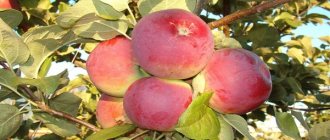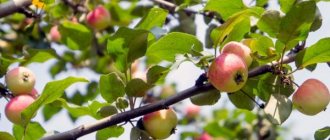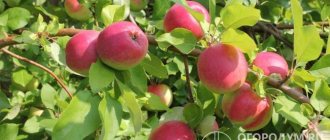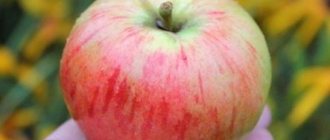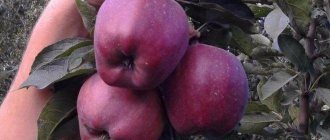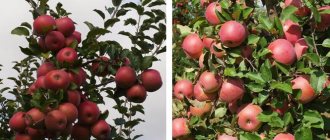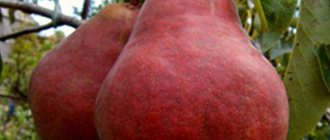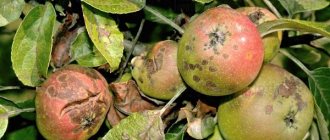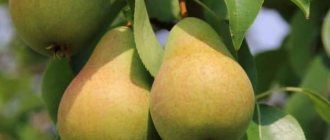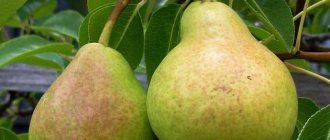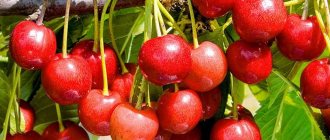Apple tree Ural bulk. Description
In the 40s of the twentieth century, at the Chelyabinsk nursery, Professor P.A. Zhavoronkov from “Papirovka” and “Ranetka Krasnaya” bred a hybrid with unique frost resistance and adaptive properties . Then the variety spread not only to the gardens of the Urals. They have taken root well in the gardens of the Far East and Kazakhstan.
Ural liquid.
Apple trees begin to bear fruit early , the yield is up to 2.5 centners per tree, they are not afraid of spring frosts - they bloom in early June. The fruits are small, but tasty and aromatic. They do not fall off the branches even after ripening. The long harvest period allows you to harvest it completely, without loss.
This apple tree is considered a semi-cultivated form because it has extraordinary growth vigor and ability to recover. A tree without pruning usually grows up to 7-8 meters . The crown under the load of the crop is formed with drooping branches.
"Ural Big"
From an unknown wild animal, Sverdlovsk amateur gardener A.G. Repin received a large-fruited variety of northern apples, “Ural Big”. The tree begins to bear fruit starting from 4-5 years of age . After 10 years, its harvest already reaches 30 kilograms. What is important is that fruiting occurs every year.
Ural big.
The Ural Large apple tree reaches approximately 7 meters . The fruits ripen in mid-September and hold well on the stalk. Greenish-yellow apples are large, weighing 150-300 grams . The pulp is juicy, aromatic, with a refreshing taste. They can remain in storage until March. Tasting score -4.5 points (out of 5).
Attention! Like “Ural Bulk”, this variety is very susceptible to scab disease. Practice shows that in the Sverdlovsk region it is better to grow such an apple tree in a creeping form, in the Cis-Ural region - on a low trunk.
How to choose an apple tree variety based on ripening time?
Apple tree varieties by ripening period
Like varieties for middle and southern latitudes, apple trees for growing in the harsh conditions of the Urals come in summer, autumn and winter varieties.
- Summer varieties of apple trees for the Urals ripen in the first half of summer. They have excellent taste and are consumed mainly fresh or processed to make summer compotes. These include: “Silver Hoof”, “Bugler”, “Korobovka”.
- Autumn apples are suitable for processing for the winter. You can use them to make jam and top compotes. In jars, for the most part, they do not fall apart (if you choose the right variety), and they perfectly retain their shape and taste. This group includes: “Rumyanka Sverdlovskaya”, “Uralets”.
- Winter varieties can be stored for a long time, until spring. After harvesting, it is left for a certain period of time, since only after 1-1.5 months the apples acquire their unsurpassed taste. Among the apple trees of this species, the following stand out: “Krasa Sverdlovskaya”, “Florina”, “Persianka”.
Read also: How many calories are in one pomegranate?
additional characteristics
Peculiarities
| “Ural liquid” | “Ural Big” | |
| Beginning of fruiting, year | 3-4 | 4-5 |
| Type of fruiting | annual | annual |
| Fruit weight, grams | up to 100 | 150-300 |
| Productivity of an adult tree, kg | up to 250 | up to 100 |
Both varieties grow as trees up to 7-8 meters in height, bloom in June, and are characterized by high winter hardiness. They have a common drawback - they are very susceptible to scab.
Annual trunk growth
The growth of the branches of the “Ural Bulk” can be classified as average: 40-60 centimeters.
But the crown is prone to excessive thickening even at such growth rates.
To prevent the harvest from getting smaller and the tree not being completely overcome by scab, apple trees need heavy annual pruning.
Mature tree height
“Ural liquid” is considered a medium-growing variety. However, trees often reach a height of 8 meters. It is clear that caring for such apple trees is incredibly difficult.
Important! The variety has a tendency to overgrow the crown, which must be thinned out regularly. Therefore, gardeners try to grow low-growing forms of this hybrid.
Crown diameter
Due to the usual abundance of fruits, the crown usually has a rounded drooping shape; often the diameter of the crown of an adult tree 15 years old exceeds 4 meters . Old trees often have too thick a crown; already at 10 years of age, apple trees of this variety need rejuvenating pruning.
Winter hardiness
In terms of winter hardiness, Ural Liquid has no competitors among cultural forms.
For example, during the abnormally cold winter of 1978-1979, when the temperature dropped to -57 C, this variety froze quite slightly; the trees recovered in one summer.
At the same time, "Antonovka" and "Borovinka" from the same gardens practically died.
Self-fertility
Unfortunately, the flowers of “Ural Bulk” have sterile pollen, this is a problem with most hybrids. For ovaries to form, a pollinator must bloom nearby.
It turned out that “Uralets” is best suited for this role . It is planted at a distance of approximately 5 meters from the “Ural Bulk”, in industrial gardens - alternating rows.
Apple tree Uralets.
Tasting assessment
The taste of Ural bulk apples is closer to sweet , with a barely noticeable sourness, for which patients of gastroenterologists appreciated the variety. These apples are ideal for people with high stomach acidity. Even people with ulcers can eat them!
The taste of apples is unexpectedly pleasant . The pulp is very tender and juicy , with a characteristic honey aroma. Apples contain about 11% sugar, vitamin C (9 mg/100 g).
Harvest of Ural liquid.
Pollinator varieties
Even at the very beginning of breeding tests, the authors were faced with the sterility of pollen from “Ural Bulk”. The problem was successfully solved, and a variety with the same unique frost resistance was selected - “Uralets”. Ideally, the best pollination is achieved when these two varieties are planted at a distance of up to 5 meters.
Advice! In industrial plantings, it is recommended to alternate rows of these varieties, this makes them easier to process.
Beginning of fruiting
In the second year after grafting, the first harvest can be harvested. There is information that after grafting by copulation, flower buds open on the scion in the year of grafting.
Fruiting is annual and stable. The apple tree quickly increases the number of fruit branches and, accordingly, the volume of the harvest.
Already at the age of 3, overload with harvest creates a threat of branches breaking. Based on many years of observations, the yield of a hectare of garden is 20 tons , one apple tree can bear 200-250 kg of fruit.
Deadlines
Blooms
"Ural Bulk" begins to bloom in early June. By this time, the threat of frost has already passed, even for the conditions of the Urals and Siberia. The “Uralets” variety used for pollination blooms at the same time - there are no problems with the formation of ovaries.
Flowering of the Ural liquid.
Maturation
The technical ripeness of Ural Bulk comes in the second ten days of September. For this variety, it is customary to distinguish three periods for harvesting fruits according to the degree of maturity , depending on the purpose:
- Apples with hard and very juicy pulp are collected for juices and compotes;
- Directly for fresh consumption;
- It comes already in October, overripe fruits are collected for processing.
Apples of the Ural bulk variety of varying degrees of maturity.
Fruiting
On trees of this variety, fruit buds are formed on fruits, twigs, and even last year's growth growths - all three possible variants of fruit branches regularly produce a harvest. Therefore, the branches age quickly and the apple tree of this variety needs regular pruning.
Fetal weight
“Uralskoye Nalivnoye” is not distinguished by large apples - on young trees the apples weigh no more than 60 grams, on old trees - up to 40 grams.
The apples are all the same size , with a characteristic yellow color on a long stalk.
On ripe apples on the sunny side, a light pinkish blush often appears.
Shelf life
“Uralskoye Nalivnoye” inherited a strong stalk . Apples do not fall off the branches even when overripe. While remaining on the tree, apples are often covered with a coating that can be easily washed off with water.
Proper storage of fruits allows you to extend the consumption of fresh apples up to 2 months versus 2 weeks. In wooden containers from special storage facilities, the temperature is maintained at about 0 C and up to 95% humidity.
The best summer hybrids
Such apple trees are characterized by early fruit ripening. In the Urals, early hybrids bear fruit consistently from year to year. Their shelf life does not exceed 4 months.
Such crops are distinguished by tasty, juicy and moderately tender pulp. They are sweet with a slight sourness. The most popular summer hybrids for the Ural region:
Summer crops are not as resilient as winter ones, so they need shelter. Mulching is carried out after harvesting.
Candy
Among the Ural species, this apple tree is the easiest option for planting. An unpretentious variety with good stable yield. The maximum number of fruits collected is set in the 9th year. From now on, the apple tree requires minimal care.
Medium sized apples. The weight of one fruit is no more than 120 g. The surface of the fruit is smooth, without pronounced ribbing. The peel color is green-yellow. As the apples ripen, they turn yellow and develop a characteristic honey color. The pulp is juicy and tasty.
The shelf life of the fruit is 70 days. The Candy variety is grown for sale - it survives transportation well. The ripe product is valuable for its iron content, which is found in large quantities in the fruits. The species is used for making cider, jelly and various compotes.
Read also: Review of thicknessing machines for wood
White filling
Medium-sized tree for the Northern and Middle Urals. It has a dense crown with dark leaves. The crown shape is pyramidal. The foliage is small in size. The surface of the plate is matte. The fruits are round and medium in size. The weight of one apple is 200 g.
The fruit has a unique taste:
- unripe fruits are sour - they have a strong aroma and the pulp is juicy;
- ripe apples are sweet and aromatic - they are softer than green fruits, and the pulp already contains up to 10% sugar;
- overripe fruits lose their taste - they become sluggish, and the pulp loses all its juiciness - people call them “potatoes”.
Lungwort
The tree is disease resistant
Among the Ural apple crops, Medunitsa stands out favorably. This is a winter-hardy species with high immunity to disease. The tall tree is densely hung with fruits - such a crop serves to decorate any garden.
The maximum height of the apple tree is 7 m. The shape of the crown is pyramidal. Shoots are formed moderately. The leaves are light green.
Medium sized fruits. Weight – 150 g. Oval shape. The fruit color is yellow-red. The stripes characteristic of the variety appear closer to the ripening period. The fruits are tasty and sweet. The pulp contains up to 15% sugar. The acidity of the ripe product is reduced, and the tasting score is at least 5 points. The aroma is pronounced.
Planting and care
Landing dates
Like most garden trees, “Ural Bulk” prefers autumn planting . Usually it is carried out no later than the beginning of October . In harsh climatic conditions, the roots must have time to take root and grow small root hairs. For planting, choose a site in a sunny place without drafts or close groundwater.
For Ural liquid, autumn planting is preferable.
A planting hole measuring approximately 0.8x0.8 meters is filled with rotted manure (2 buckets), superphosphate and ash (250 grams each), and potassium salt (100 grams). Mix it with soil and plant the apple tree, tying it to a peg. The root system of the seedling must be protected from soil freezing with a layer of mulch.
Features of cultivation
An apple tree of this variety can bear fruit in the first year after planting. But this will greatly weaken it, so it is better to pick off the first flowers.
Without waiting for the development of diseases in the garden, carry out standard measures for the spring prevention of fungal infections. Remember, the variety is very susceptible to scab.
Treatment with Bordeaux mixture will help stop the development of scab and other garden diseases:
- The first treatment is before the buds open,
- The second - after blooming,
- The third is before the flowers bloom.
Attention! “Ural Bulk” is a sterile hybrid and will not bear fruit without cross-pollination. It should not be sprayed during flowering under any circumstances, otherwise you will be left without a harvest.
In the fall , after harvesting, carry out sanitary and anti-aging pruning of trees . Before winter, be sure to whitewash the trunks with lime mortar to protect them from sunburn. To protect against mice and hares, tie the trunks of young trees with spruce branches or paper.
Agricultural technology
When growing the Ural Bulk variety, garden care is no different. Agricultural techniques are completely standard:
- Timely spring pruning and preventive spraying of bare branches against fungal diseases and pests;
- Treatment of the garden with Bordeaux mixture every 2-3 weeks against scab (up to 7 times per season);
- Mineral foliar garden feeding (can be combined with antifungal spraying);
- Timely pruning not only rejuvenates the tree, but also increases resistance to fungal diseases;
- The variety is susceptible to sunburn; in the fall, be sure to whitewash the trunks;
- Before winter, the trunk circles of a young tree must be mulched with sawdust, peat or straw.
What varieties can be grafted onto?
any wild wood can be used as a rootstock , preferably the “Antonovka” type. But for cold climate conditions, in order to grow “Ural bulk” in stale form, it is better to graft onto clonal rootstocks such as quince, chokeberry or ordinary rowan . Apple trees on such rootstocks do not grow higher than 2.5 meters. They can be bent to the ground for the winter; they hibernate under the snow.
Ural bulk can be grafted onto quince.
Basics of agricultural technology
Planting work can be carried out in spring (early April) and autumn (in the first ten days of October).
The latter period is preferable, since the apple tree takes root better by spring, goes into active growth, and during the winter strengthens its immunity.
Landing
The optimal place to purchase apple tree seedlings is a local specialized nursery.
Landing can be done in several ways:
- through seeds;
- seedlings;
- grafting.
Most often, gardeners use seedlings when breeding this variety . When selecting planting material, special attention is paid to the rhizome of the plant. It should be intact, well developed and moist.
It’s also worth taking a closer look at the branches of the young tree. They should be flexible and elastic, without wounds, plaque or uncharacteristic stains. The bark of a healthy seedling has no growths. It is worth paying attention to the kidneys. They should be alive and slightly swollen. The best age for a seedling is 2 years. To guarantee quality, it is safest to purchase planting material from a nursery, rather than from a market or bazaar.
Selecting a location
The place for apple trees must be chosen taking into account their further growth.
The site for future planting should be well lit and protected from draft winds . Groundwater should be no closer than 2 meters. The preferred soil is loamy soil or sandstone. It is on them that the variety shows the highest yield.
The depth of the planting hole does not exceed 0.7 meters, the diameter is no more than 80 cm.
Construction of a landing pit.
The bottom is additionally dug up by 10–15 cm , after which drainage consisting of expanded clay, crushed walnut shells or coarse sand is introduced there. Then 10–12 liters of water are poured into the hole and a pair of pegs are installed for tying.
Preparation
A support stake is installed in the center of the planting hole.
The top fertile layer (10 kg) from the dug hole is mixed with the following types of fertilizers:
- 20 kg of rotted mullein;
- 250–260 grams of wood ash or slaked lime;
- 250–260 g of superphosphate;
- 120 grams of potassium sulfate.
Part of the mixture is poured into the hole, a small mound is formed, on which a seedling with a preliminary straightened root system is placed. After which the tree is carefully covered with the remaining soil.
Important: the root neck of the apple tree should “protrude” above the ground by at least 3–5 cm.
The root collar is the place on the trunk of the seedling where the darker color begins.
Having filled the hole, you need to carefully compact the soil around the seedling and pour warm water over everything. The young apple tree is tied up, and the trunk circle is covered with mulch.
It is better to immediately cover the tree trunk circle with mulch, under which moisture will be retained.
Care
Systematic watering is a vital necessity for an apple tree in its first year of life.
One tree requires 20–25 liters of water. Watering is carried out once every 7–8 days, but in hot weather the number of approaches can be doubled. Once every 2 weeks the green crown is sprinkled.
Top dressing
With proper care, the Uralskoe Nalivnoe apple tree begins to bear fruit within 2–3 years.
After about 1-1.5 years, the soil under the crop begins to become poor. It requires fertilizing in the form of organic matter and potassium-phosphorus and nitrogen fertilizers. Feeding is carried out every 4 years .
The first fertilizers are applied during planting. The second - before the beginning of the flowering stage, then at the end of this period. The fourth feeding is carried out at the moment of fruit formation. And the last fifth - in the fall.
- From the beginning of April to mid-summer, urea and saltpeter are added, that is, a nitrogen type of fertilizing.
- In autumn - potassium-phosphorus fertilizers.
Organic matter can be introduced in both of these periods.
Trimming
Apple tree pruning is carried out in the 2nd year after planting. It is necessary for the formation of the correct crown.
The principle of forming the crown of an apple tree.
If this is not done, the crown grows and becomes too thick, which affects the formation of buds and fruits. In addition, if branches grow uncontrolled, they may begin to break under the weight of the harvest. From this point on, pruning is carried out annually for the next 4 years.
Sanitary pruning is carried out in the fall. All weak, damaged and infected branches are removed.
Subspecies and options
The climatic conditions of the Urals and Siberia are characterized by unpredictability and harsh winters. The requirements for garden crops are very high, especially in terms of winter hardiness and endurance. All the most adapted varieties of apple trees can be divided in descending order of winter hardiness:
- Bush-like ranetki (the most winter-hardy) with small fruits up to 15 g;
- Semi-cultures - with fruits 15-30 g;
- Large-fruited stans are artificial varieties with low winter hardiness.
Autumn yellow
This is the classic “Ural Bulk”, grown as a fairly tall tree (up to 7 meters) with a drooping thickened crown and small yellow apples that ripen in September.
Subspecies Autumn yellow.
Standard
To limit the vigor of an apple tree, it is often not grafted onto a dwarf rootstock, but rather a so-called “ insertion” of a dwarf crop . This allows the growth of the tree to be limited, but the root system remains deeply penetrating and not dwarf with all the disadvantages of shallow roots.
Dwarf
Grafting cuttings onto rowan and clonal quince rootstocks make it possible to grow Ural Bulk in a dwarf form.
Dwarf gardening has a bright future as this form of gardening allows for the mechanization of garden cultivation.
Low trees up to 2.5 m high are easy to treat for diseases, prune and harvest.
Semi-cultured
The form of “Ural bulk” is recognized as half-cultivated , since the genetic characteristics of wildflower (small-fruited and high winter hardiness) dominate. The unique ability of the semi-cultivar to adapt to any conditions is a huge advantage of the variety.
Important! The apple tree has a tendency to thicken the crown and has low growth vigor. Any damage is restored very quickly.
Features of cultivation in the regions
The Ural Bulk apple tree variety was originally intended for the conditions of the Urals and Siberia , where the choice of horticultural crops is very limited. Gardeners are primarily interested in the reliability and plasticity of trees, the taste of fruits and yield.
Siberia
Siberian gardeners began to grow apple trees not so long ago - for the last 50 years. The varieties of Barnaul selection based on Sibirka (a local semi-culture) were successfully complemented by Ural Bulk.
The variety fits well into both the climate map and the soil map. It has also been successfully grafted into the crown of local Siberian grass .
The use of local semi-cultivated forms such as Siberian as a pollinator and rootstock for the Ural Bulk hybrid has made gardening a reality even in the Krasnoyarsk Territory.
For an overview of apple trees grown in Siberia, including Ural Bulk, see the video below:
Tyumen region
Tyumen gardeners successfully grow varieties from the Sverdlovsk breeding station. The use of standard forms with a dwarf insert allows you to grow apple trees in the form of stanlets. This saves the trees from the drying effects of winter winds.
Nuances and questions from readers
How to prune a seven-year-old neglected apple tree?
If the development of an apple tree is left to chance , by the 7th year of growth you will end up with an already aged tree . Putting it in order is not at all difficult, considering that this is an apple tree from Ural Bulk. It’s best not to put it off “for later”, to prune it in the spring, when the snow has melted.
It is necessary to mentally divide the tree into tiers. Leave 3-4 branches in each tier, cut the rest into a ring.
Anti-aging pruning.
Advice! Do not be afraid to prune the apple tree too much - this variety will grow branches even too quickly. The freer the crown space, the less pain the tree will have and the larger the apples will be.
Thin out small overgrowing branches as much as possible. From Ranetka, “Uralskoye Nalivnoye” inherited fruiting on all possible types of fruit trees.
Where to buy a seedling?
Of course, it is best to purchase seedlings from the direct manufacturer - in a fruit nursery or breeding station. In the autumn season, retail sale of planting material is carried out at various specialized fairs.
At one of the traveling exhibitions and fairs in September 2021 in Tyumen called “Autumn Garden and Vegetable Garden. Honey Fair” marketing development sector, one Chelyabinsk company conducted a sociological survey among buyers of seedlings.
Similar traveling fairs are regularly held in other cities in the region:
- Miass;
- Nizhny Tagil;
- Chelyabinsk;
- Kurgan.
Reviews
Andrey, 58 years old, an experienced amateur gardener. “After retirement, I began to actively engage in gardening. I was convinced from my own experience that there is currently no alternative to this hybrid in our climate. All its shortcomings (small fruits and the need for repeated scab treatment) are successfully compensated by the regular harvest of juicy apples, which are also very tasty. I want to give a seedling to my neighbor in the country for his birthday. And our pollinator grows on the border of the plot.”
Anna, 52 years old, grandmother. “The family is growing, two grandchildren are growing up. Vitamins are not imported. The variety has already been tested on the site, and we decided to plant another apple tree. They advised me to buy it on a dwarf rootstock to make it easier to care for the tree. It’s hard to trim branches at height, and you can’t do without it - it hurts a lot and the apples get smaller.”
Vladimir, 34 years old, aspiring summer resident. “I decided to start an apple tree for Ural Bulk, following the example of my neighbor. Three years ago, at the same exhibition, he purchased a seedling. And just the other day I treated him to apples he had grown himself. Of course they are small, but very tasty and juicy.”
The hardiest crops
For gardeners whose land plots are located in the Urals, another characteristic is important - the hybrid’s resistance to common diseases.
Apple trees may suffer from scab or powdery mildew. A distinctive feature of the Ural climate is a large amount of precipitation - this is high humidity, which creates a dangerous situation for trees. To prevent rotting diseases from spreading throughout the garden, resistant apple varieties are chosen.
Souvenir
The souvenir has the best selection characteristics. The variety has large fruits and a long shelf life. The hybrid, beneficial for gardeners, can be planted on any plot of land. It is highly adaptable and requires minimal maintenance.
In warm climates, fruit trees grow very well, but in the harsh Urals, not all crops can take root. Apple tree varieties for the Urals must first of all be resistant to severe frosts. All varieties of apple trees listed below have this quality, but in addition, they are distinguished by their productivity, pleasant taste and ease of care.
